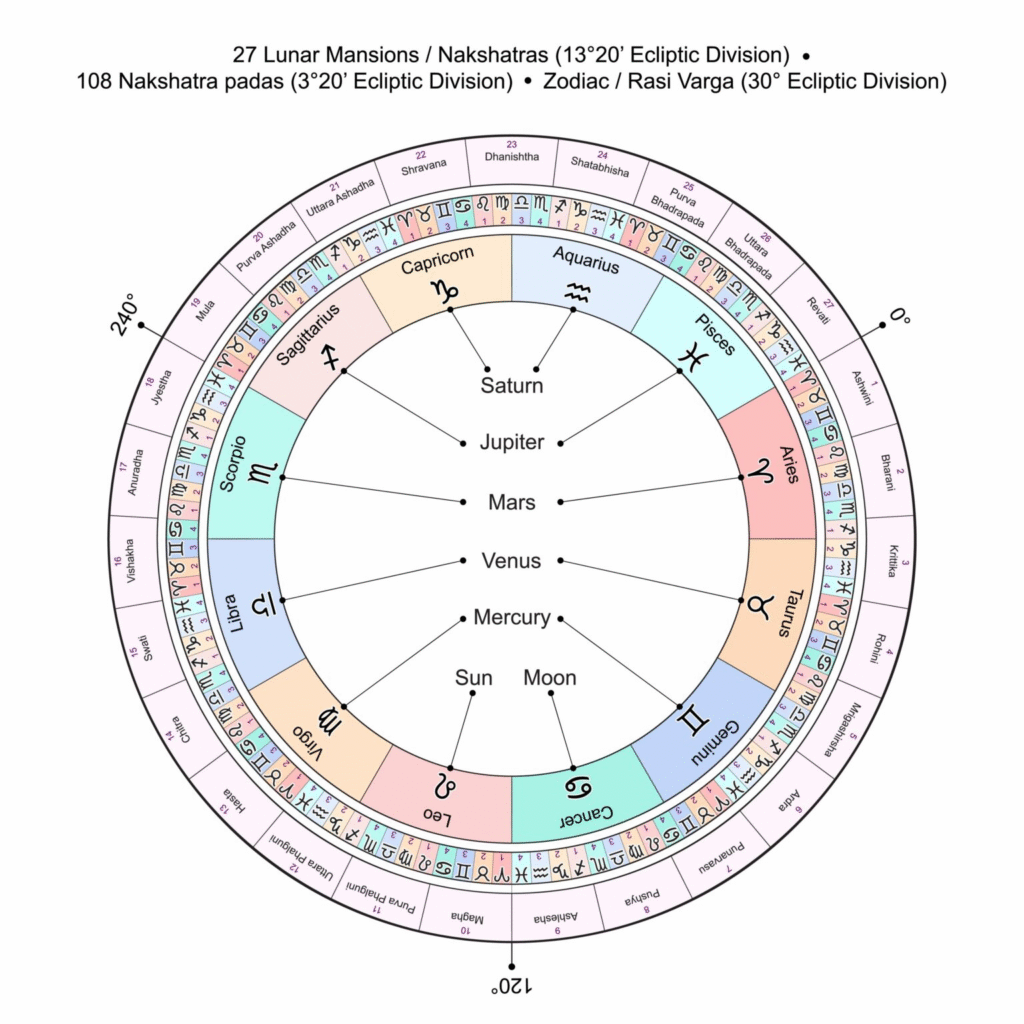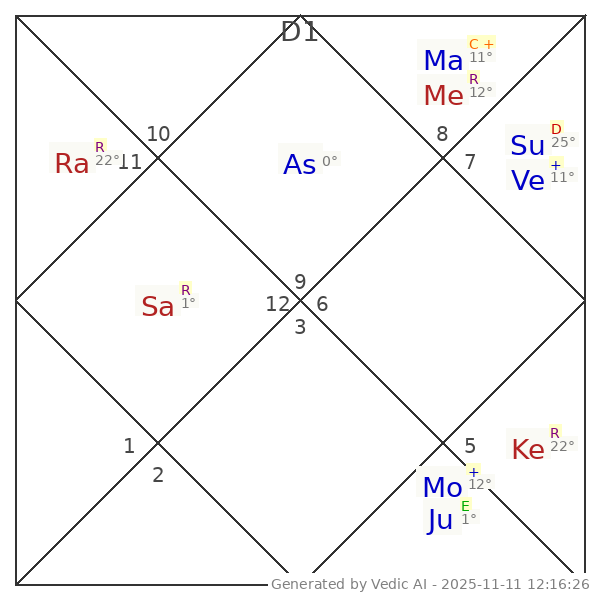The Nakshatras, or Lunar Mansions, are the foundation of Vedic Astrology (Jyotisha). They provide the most detailed and refined understanding of planetary influences, far exceeding the 12-sign zodiac system used in the West.1
Introduction to Nakshatras 🌕
Nakshatra literally translates to “that which never decays” or is sometimes poetically called the “star-body of the Moon.” The system divides the 360-degree ecliptic (the path of the planets) into 27 distinct segments, each measuring 13 degrees and 20 minutes (13°20′).2
Each Nakshatra is a celestial residence for the Moon (Chandra), which transits one Nakshatra every day. The Moon represents the mind, emotions, and consciousness in astrology, so the Nakshatra it occupies at the moment of birth is the single most important factor, defining the native’s fundamental nature and controlling the primary predictive system (the Vimshottari Dasha).
Key Influencers of a Nakshatra
Every Nakshatra is a powerhouse of specific energy, defined by a hierarchy of influences:3
- Nakshatra Lord: A planetary ruler (Ketu, Venus, Sun, Moon, Mars, Rahu, Jupiter, Saturn, Mercury) that governs the Nakshatra and determines the sequence of your life-timing periods (Dashas).
- Nakshatra Deity: A presiding Vedic deity (e.g., Agni, Vayu, Vishnu) that grants the specific Shakti (power) and symbolic meaning to the star.4
- Gana (Temperament): Classifies the nature of the Nakshatra as Deva (divine), Manushya (human), or Rakshasa (demonic), primarily used for compatibility analysis.5
- Group/Quality: Categorizes the Nakshatra’s nature (e.g., Sthira – Fixed, Chara – Movable, Ugra – Fierce), which is crucial for Muhurta.6
Relevance in Astrology (Jyotisha)
In a birth chart, the Nakshatra provides depth to all planetary placements, but its influence on the Moon is paramount:
1. Determining the Basic Nature (Chandra)
The Nakshatra the Moon is placed in at birth determines your mental, emotional, and psychological makeup.7 This Moon Nakshatra is the root of your personality and is often used to name a child (Namakarana).8
2. The Predictive System (Vimshottari Dasha)
This is the most critical function. The Nakshatra Lord of the natal Moon determines the starting planetary period (Dasha) in the predictive system. This system of 9 planetary periods defines the major events, opportunities, and challenges that unfold throughout a person’s life.
3. Compatibility (Ashta-Koota)
For marriage matching (Kundali Milan), the Nakshatras are used in the Ashta-Koota system.9 The Gana, Yoni (animal symbol), and other Nakshatra attributes are compared between the two individuals to assess their psychological, sexual, and spiritual compatibility.
Relevance in the Panchang
The Nakshatra is one of the five essential limbs of the Panchang (the Tithi, Nakshatra, Vara, Yoga, and Karana) and is crucial for Muhurta (selecting an auspicious time).10
| Panchang Term | Function | Purpose in Muhurta (Auspicious Timing) |
| Nakshatra Group (Sthira, Chara, Ugra, etc.) | Defines the fundamental quality of the day. | Dictates the types of activities favored: Sthira (fixed) for laying foundations; Chara (movable) for starting travel; Ugra (fierce) for military or difficult acts. |
| Nakshatra Veto | Combinations with the weekday. | Certain Nakshatra and Vara (weekday) combinations create the highly inauspicious Sarvartha Siddhi Yoga (auspicious) or the severely malefic Rikta Nakshatra Dosa (to be avoided). |
| Padas (Quarters) | Refinement of the Nakshatra (3°20′ arc). | The Nakshatra is divided into four Padas (quarters), which correspond to the Navamsa Signs. This refines the timing by layering on a secondary planetary influence (Navamsa Lord) to determine the success and spiritual quality of the Muhurta. |
The Nakshatra is not governed by one factor, but by a hierarchy of five forces, from the broadest (Sign Lord) to the most specific (Pada Deity).

Here is a breakdown of all the key influencers on a Nakshatra and its Padas, explaining their relevance:
The Hierarchy of Nakshatra Influencers
The quality of a planet’s placement in a specific 3°20′ arc is determined by these five forces working together:
1. Rashi (Sign) Lord: The Body & Environment
The Rashi (Zodiac Sign) Lord provides the physical environment and material body of the planet’s influence.
- What it is: The planet that rules the 30° zodiac sign that the Nakshatra (or part of it) occupies (e.g., Mars rules Aries, Venus rules Libra).
- Influence: It governs where and how the Nakshatra energy manifests in the physical world and the native’s character (e.g., Swati is in Libra, so its energy is framed by Venusian themes like relationships and balance).
- Relevance: The broadest, most foundational influence.
2. Nakshatra Lord: The Vimshottari Dasha & Mental State
The Nakshatra Lord is the planet that rules the 13°20′ arc and is the basis of the entire Vimshottari Dasha (planetary period) system.
- What it is: The planetary ruler of the 27 Nakshatras (e.g., Ketu for Ashwini, Venus for Bharani, Rahu for Swati).
- Influence: It defines the planet’s mental state, inner desires, and the timing of events in a person’s life (via the Dasha system). This is the most important planetary influence on the Moon’s mind.
- Relevance: Critical for both character analysis and predictive timing.
3. Nakshatra Deity: The Spiritual Source & Core Power
The Nakshatra Deity governs the spiritual source and core power (Shakti) of the lunar mansion.
- What it is: The Vedic Deva/Devi presiding over the 13°20′ arc (e.g., the Ashwini Kumaras for Ashwini, Vayu for Swati).
- Influence: It determines the innate nature, power, and blessing of the Nakshatra (e.g., Swati has the power to scatter like the wind, granted by Vayu).1
- Relevance: Crucial for understanding the mythological and symbolic nature of the Nakshatra, and for Upasana (worship).
4. Navamsa Lord (Pada Lord): The Soul & Inner Fortune
The Navamsa Lord (or Pada Lord) is the main factor that refines the Nakshatra quality into one of four quarters.
- What it is: The planetary ruler of the sign the 3°20′ quarter falls into in the Navamsa (D-9) chart.
- Influence: It dictates the soul’s motivation, the inner character, and the ultimate fortune (bhagya) derived from the Nakshatra placement.
- Relevance: Highly Relevant for Muhurta and deep character analysis, as it dictates the practical execution of the Nakshatra’s energy.
5. Pada Deity: The Micro-Ritual and Immediate Focus
The Pada Deity (or Chaturthamsha Devata) is the most minute and specific spiritual influence.
- What it is: One of the canonical 12 or 16 deities assigned to the 3°20′ quarter in a fixed, non-zodiacal cycle.
- Influence: It governs the immediate spiritual vibration, the nature of micro-level obstacles, and the specific deity to propitiate for immediate protection and results.
- Relevance: Crucial for very specific ritual timing and identifying the most direct spiritual path.
Summary Table
| Influence | Arc Span | Plane of Action | Primary Use | Swati Example (Pada 1) |
| Sign Lord | 30° | Physical/Material | Foundation, Physicality | Venus (Rules Libra) |
| Nakshatra Lord | 13°20′ | Mental/Timing | Timing (Dasha), Core Desire | Rahu |
| Nakshatra Deity | 13°20′ | Spiritual Source | Upasana, Core Power (Shakti) | Vayu |
| Navamsa Lord | 3°20′ | Inner Character/Dharma | Muhurta, Soul’s Fortune | Jupiter (Rules Sagittarius Navamsa) |
| Pada Deity | 3°20′ | Micro-Ritual/Blessing | Specific Rituals, Obstacle Removal | Ganesha (One of 12 cycle deities) |
For a Nakshatra, this concept of nested influences determines the outcome a planet has.








